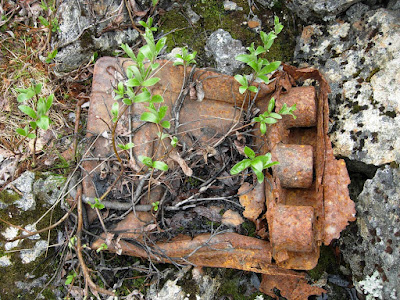Mikke with one of the first finds indicating an aircraft. Part of landing gear?
This year´s Narvik hike provided me and my good friend Mikke with several surprises, not least finding many uniform parts in German positions and lots of bits and pieces of a British dive bomber.
After more than a decade of Narvik hiking (see e.g. my previous post re. Ju 52 with paratroopers) the region still delivers great encounters with both nature and history. Some finds on this 4 day hike:
German mortar position with signs nobody has been in it for decades.
Some paint left on the wood inside the carrying case.
In the middle of nowhere, huge shrapnel most probably from a gun onboard a warship in the Rombak fjord, i.e. either of British or German origin.
One of the first proper rifle/machine gun positions we found. In the background mountains where some Swedish volunteers in the Norwegian Army fought. Position may not look that spectacular from this angle, but...
...look closer at the ground around it and you see perfect evidence of the shooting that was going on here. Note that this is how we found it. Rounds dated 1936-39. Please do not touch complete ammunition, for your own safety. Remember, even First World War ammunition can cause injury/death.
A bit more unexpected: thick cloth, originally black. Just like we found it. In the Narvik area it is today very rare to find uniform remains in the open.
The cloth leads us to a kind of cave probably used for resting and inside it, on the ground is a mass of the same type cloth that has obviously disintegrated after decades of contact with water. But it is possible to make out some greatcoats with large shoulder boards. Here you see just the shoulder boards.
But we also found some originally probably field grey shoulder boards. This is one of the most intact. Yes, I moved the boards and the below artifacts to take these photos, but then I put them back in the position ("cave"). One should put stuff back both for legal reasons (Norwegian law) and for the benefit of future hikers.
Black shoulder board, insignia for a private, a plain metal button and the back end of a Norwegian Krag rifle. An experienced Norwegian friend has seen these photos and identified the greatcoats thanks to the boards and button - they are late 19th century Norwegian Army greatcoats captured and used by German troops. Lots of German equipment had been sunk.
Speaking of sunk, in a small lake by one of the later positions we found there were a dozen more Madsen machine gun magazines. It is also certain that many of these were captured and used by the Germans. These positions were only used by the Germans.
Among the mags was also an older Madsen type, made of lighter metal.
Then, going back towards the Swedish border, we start finding this stuff. We think "aircraft", and then...
...we find hundreds of various bits and pieces of light metal. We know from an online Norwegian warbird archive that a carrier-based (HMS Ark Royal) British Blackburn Skua dive bomber/fighter aircraft was found in the area. But according to the archive photos there should today be very little left to see and thus we had not at all been searching for Skua remains.
Even some remains of blue Royal Navy paint, which I reckon indicates the tail of the aircraft. How can the paint be so bright after so many years? Well, it is mostly covered by snow.
We then followed the route of the two surviving British airmen and were impressed at how the men managed to slide down a very steep and long slope to the innermost part of the Rombak fjord (please do not try doing that). From there they were rescued by the British destroyer HMS Bedouin.
Before going back into Sweden we stumbled upon some more German remains in Björnfjell, just lying about in the open. Machinery parts with German instruction plates still very readable.
Although we have been by the Björnfjell railway station a number of times we had missed this old metal sign with very faded letters and bullet holes. Probably from the fighting in May 1940. To see photos larger just click on them.
If you are wondering why we took no souvenirs from the Skua it is because it would be illegal and also because they will probably fascinate future hikers and might some day also be helpful for a museum display. The parts acually still belong to the Royal Navy. If one wishes to remove parts for a museum or other display one must contact, in this case, first the UK Ministry of Defence and then the the Norwegian Aviation Museum in Bodoe.
If you are keen to get tips re Narvik hiking areas I recommend my book Jan och Nordens frihet (in Swedish) and a future book of mine in English that might be out in 2017.
Thank you Mikke, for a tough and beautiful hike into history.


















